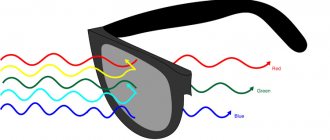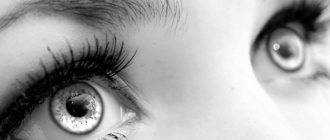Color blindness is an eye pathology. It is usually congenital, but less common and acquired. The term “color blindness” stands for unhealthy color perception. More specifically, the ability to perceive different tones is lost to varying degrees. Color blindness in men is diagnosed using various methods: the Ishihara test, the FALANT test, anomaloscopy, and Rabkin’s polychromatic tables. Medicine does not yet know how to cure this. But there is symptomatic treatment. There are two options. The first is based on the use of glasses with special filters built into them, as well as special contact lenses. The second requires specialized programs and technological devices for working with color images.
Color blindness in men
How does colorblindness manifest in men?
- 11.1 Video - What is color blindness?
With this pathology, the activity of retinal receptors is disrupted, although all other eye indicators are within normal limits. The disease received its name from the British scientist Dalton, who had a genetic form of pathology. In 1794, he described it in detail.
John Dalton
This disease occurs more often in males than in females. The exact figures are as follows: among them, the disease occurs in 2-8% of cases, and among women – only 0.4%. If we judge the development of the disease according to statistics, deuteranomaly is found among men in 3 out of 50 cases, protanomaly in one out of a hundred, and tritanomaly even less often. The rarest form of color blindness is achromatopsia. It occurs in only one man out of 35 thousand. According to scientific data, it most often occurs as a result of incest. On the Micronesian island of Pingelap, inbreeding even gave rise to a so-called “color-blind society.”
Types of color vision anomalies
How does this disease appear?
Etiologically, it appears as a result of deterioration in the functioning of receptors located in the ]retina[/anchor]. There are three different types of cones in the eye. They contain a protein pigment that perceives light. The type of receptor is determined by what color it perceives. It is thanks to pigments that react to the main colors (green, red, blue) that it becomes possible to perceive everything around in bright colors.
Men are more likely to become victims of color blindness than women
The genetic form appears through the process of mutation of the X chromosome. Because of this, children whose mothers are carriers of a damaged chromosome suffer greatly from this disease. A girl or woman is colorblind only if her father and mother were carriers of the anomaly. Genome mapping has revealed that changes in more than nineteen different chromosomes can lead to pathology, and deviations in 56 genes can cause color blindness. But hereditary factors are not the only reason why a person has color blindness.
Inheritance in color blindness
It can also be caused by genetically inherited abnormalities:
- cone degeneration;
- Leber's amaurosis;
- retinitis pigmentosa.
Leber's amaurosis
Even an adult can get sick from this if:
- the brain, or rather the occipital lobe, is damaged due to injury;
- suffered a heart attack or stroke;
- gradual destruction of the retina occurs;
- post-concussion syndrome appears;
- there are neoplasms of various types;
- the eye has been exposed to ultraviolet rays;
- intoxication of the body occurred - temporarily.
Receptor apparatus of the eye responsible for color vision
This ailment may also be a symptom of the following:
- cataract;
- diabetic form of retinopathy;
- Parkinson's disease.
Symptoms of Parkinson's disease
Are there many colorblind people in Russia?
The world through the eyes of colorblind people
Today in Russia there are about four million people suffering from color blindness, which is approximately four percent of the total population. Not so little. Color blindness is a hereditary disease, although in rare cases it can be acquired, when a person cannot distinguish certain colors. Color blindness is also called color blindness, but this is not entirely true, because a color blind person cannot distinguish only some colors, sometimes just one. This disease was discovered by Dalton at the end of the 18th century, who himself could not distinguish the color red and only realized this at the age of thirty. He had two brothers who were also colorblind. Based on his studies of himself and his brothers, John Dalton wrote a famous book about color blindness.
Color blindness is divided into two types: hereditary and acquired. Hereditary color blindness is transmitted to the son from the mother, and acquired color blindness appears as a result of damage to the retina or optic nerve. You can only identify a colorblind person with special medical tests, which are small tables with numbers drawn on them that consist of one color, but around these numbers there are many other dots of the same size that differ in color but have the same brightness level. A person with normal vision can easily distinguish these numbers and will not have any difficulties with this, but a person with color blindness will not be able to distinguish numbers that are drawn in a color that he does not distinguish. In these tables, along with numbers, there are also geometric shapes.
According to many doctors, color blindness is an incurable disease, but nevertheless, a person suffering from it can live quite normally in society with almost no discomfort. There are only some restrictions for colorblind people, for example, they cannot drive a car or work in a job where it is necessary to distinguish between all colors. Such a person most likely will not be able to become a doctor or military man. We may not even know that your friend or work colleague sees differently from you, but people usually do not experience any restrictions in life and some of them may not even know that they are color blind. In recent years, scientists have been looking for ways to treat this disease and this has already brought some results; they have proven that it is still possible to cure color blindness using the latest genetic engineering methods.
How to recognize?
Among the signs of this disease, the most important is the inability to determine a specific color or its shade. There are several types of this pathology:
- deuteranopia, when the patient does not understand where green is and where blue is;
- tritanopia, when the patient is able to identify only red and green;
- protanopia, when the patient does not perceive the color red or green;
- trichromasia, if a person recognizes the main colors. This also happens in a healthy person, which means it cannot always be considered a disease;
- achromatopsia, when it is not possible to distinguish any shades at all.
Types of color blindness and statistics
There are also two forms of the disease - congenital and inherited. Some patients are unaware of the development of the disease until they contact an ophthalmologist. Only after visiting an eye doctor who diagnoses the problem do they begin treatment.
There is also the so-called emotional colorblindness - the inability to separate the nuances of someone else’s mood.
Emotional colorblindness
Protanopia
This type of pathology affects approximately 7.5% of men and about 0.35% of women. The patient cannot make out any shades. Usually this type of disease is genetic. Therapy is not possible. This type is due to the presence of the color blindness gene.
Protanopes incorrectly distinguish the following colors: green, yellow, purple shades
Protanopia is caused by the fact that there are no cones in the retina that are responsible for a person to normally distinguish orange-red shades. To him, yellow-green is like orange, and purple is like blue. What is surprising is that he is able to distinguish between green and blue, as well as bright red and green.
Deuteranopia
This type of color blindness is usually congenital. It affects approximately every hundredth person. A patient who sees pictures made in purple, yellow-green, blue-green colors does not have the ability to see and understand them correctly.
Deuteranope color perception
This form is explained by the absence of chlorolab on the patient’s retina. This pigment is necessary for the perception of red and green colors. But such a patient can perfectly recognize where is green and where is red or purple.
Tritanopia
This color blindness is a poor perception of different colors. This is an extremely rare species and usually has a congenital form. Tritanopia occurs in women with the same frequency as in men. This is because it appears due to a “surprise” in chromosome VII, and does not depend on gender.
Tritanope world picture
Manifestations of this type of illness are difficulties in distinguishing blue-yellow, purple, and red.
Achromatopsia
What are the differences between color blindness and achromatopsia? They are that the second is absolute insensitivity to colors. Then the patient perceives everything in black and white. Achromatopsia has a couple of types:
- rod , when there are no cones at all, necessary for perceiving the world not in the black and white spectrum. Then the patient sees all the light that reaches the retina as gray, like the images on the very first televisions;
- cone , when the patient perceives “all the colors of the rainbow” in one tone.
The world for people with achromatopsia looks black and white.
Achromatopsia is an extremely rare type of color blindness. As a rule, this is a genetically inherited form of the disease. It comes with secondary symptoms such as nystagmus and photophobia.
Anomalous trichromasia
This type of disease means difficulty in distinguishing some individual tones. And the patient can distinguish most shades without problems. Trichromasia has three forms:
- A - the patient practically does not perceive green and red;
- B - colors are difficult to perceive, and this is a big problem;
- C - mild form, causing virtually no inconvenience.
If any specific colors are perceived incorrectly, other colors, on the contrary, become clearer for perception.
A person who has anomalous trichromasia cannot perceive only one color
This pathology does not develop over time. It neither sharpens nor dulls vision. Due to certain difficulties, such patients are never allowed into certain professions. There are areas of activity in which color blindness prevents you from working well. If someone with color blindness starts working in this field, the consequences will be dire. Here are examples of professions where such patients should not work:
- driver;
- sailor;
- pilot;
- medic
You cannot become a pilot with such a pathology
So during a medical examination, all men applying for this type of work are necessarily tested for their ability to perceive and distinguish colors.
Selective vision
There is a misconception that colorblind people cannot distinguish colors at all. But statistics show that only 0.1% of people see the world in black and white. Typically, colorblind people may not be able to distinguish between any one color. John Dalton, after whom the disease is named, did not perceive the color red.
Moreover, most often, people suffering from color blindness do not experience a loss of any color from the visible spectrum, but a weakened perception of it. Science identifies three color anomalies: 1. Protanopia - deterioration in the perception of red color. People suffering from this pathology may confuse red with brown, dark gray, black, and sometimes with green. 2. Deuteranopia – difficulty perceiving the color green. There is a mixture of green with a light orange tint, and light green with red. 3. Tritanopia - problems with the perception of violet and blue colors. In this case, all shades of blue appear red or green. Much less common is complete blindness to green or red.
Diagnostic methods
To identify color blindness, oculists use the following methods:
- FALANT test;
- Ishihara color test;
- anomaloscope;
- Rabkin's polychromatic tables.
The Ishihara test uses photographs. It shows colorful spots. All together they make up a certain picture, but some part of it is not visible to the patient, and he cannot say what is depicted there. This test also includes images of figures. For example, numbers or geometric shapes. Here the figure blends into its background, and colorblind people usually see only it. After all, it is difficult for them to detect minor differences in shades. If a child who has not yet learned numbers takes the test, special drawings for children are used to examine him. Using Rabkin's tables they test in approximately the same way.
Ishihara test
Examples of Rabkin tables used to determine color blindness.
| Table | Description |
| All normal trichromats, abnormal trichromats and dichromats distinguish the numbers 9 and 6 equally correctly in the table (96). Such a table is needed only to demonstrate the method and to determine goals. | |
| People without visual impairments distinguish the number 9 in the table. Protanopes and deuteranopes distinguish the number 5. | |
| People without visual impairment see a triangle in the table. Protanopes and deuteranopes see a circle. | |
| People with normal vision see two figures in this table: a circle and a triangle. Protanopes and deuteranopes do not distinguish anything. | |
| People without visual impairments and deuteranopes distinguish the number 9 in the table. Protanopes read it as 6 or 8. | |
| People with normal vision distinguish numbers 1, 3 and 6 in the table. Protanopes and deuteranopes read any two numbers instead - 66, 68 or 69. | |
| People without visual impairments and deuteranopes distinguish numbers 1 and 2 in the table (12). Protanopes do not distinguish anything. | |
| People without visual impairments distinguish the numbers 3 and 0 at the top of the table, but do not distinguish anything at the bottom. Protanopes read the numbers 1 and 0 at the top of the table, and the number 6 at the bottom. Deuteranopes read the number 1 at the top of the table, and the number 6 at the bottom. | |
| People without deviations distinguish two figures: a triangle and a circle. Protanopes distinguish a triangle in the table, and deuteranopes - a circle. | |
| People with normal vision distinguish between a circle and a triangle in the table. Protanopes and deuteranopes do not see them. |
There are several methods for diagnosing the disease
But it becomes possible to use the FALANT test and anomaloscopy methods only when there is a great need, such as hiring a person for a job where very serious demands are made on color vision. Anomaloscopy allows you to identify all types of illness, and also understand how the following factors affect the functioning of your eyes:
- ambient light brightness;
- adaptation to colors;
- duration of observation;
- air composition;
- Atmosphere pressure;
- patient's age;
- noise;
- classes on identifying shades;
- taking medications.
This method of examination is used to determine how well a person can perceive and distinguish shades, when this is necessary to determine whether he is suitable for certain jobs. This is also necessary to monitor therapy.
The simplest test for color blindness
Americans use the FALANT test to examine potential military personnel. To pass this test, you need to recognize the color that the beacon emits at the required distance. It consists of three colors, slightly muted using a filter. Those who are disadvantaged by color blindness are unable to recognize the hue of the beam. Approximately a third of those with a mild form of pathology successfully pass this test.
Congenital color blindness is detected at later stages of development. This is because patients often name shades differently than they see them. If the family history is severe, the patient should be examined by an ophthalmologist as quickly as possible. The classic form of this disease does not progress, but the secondary form, which arises due to other eye pathologies, provokes the development of myopia, as well as dystrophic lesions of the retina. So then you should quickly begin to treat the underlying disease. Congenital color blindness spoils only color perception, but does not affect any other visual characteristics. So, if vision becomes dull or its field is narrowed, even diagnosed color blindness has absolutely nothing to do with it.
People who have an acquired form of color blindness should undergo annual examinations
Additional examination of the patient is required for acquired color blindness. Being a primary disease, it can not only spoil other visual parameters, but also cause organic eye diseases. So it is important for owners of acquired color blindness to undergo the following examinations every year:
- tonometry;
- ophthalmoscopy;
- perimetry;
- refractometry;
- biomicroscopy.
Refractometry in ophthalmology
Every tenth man is colorblind?
You ask: “Honey, how do you like my new coral dress?” and you get the answer: “Yes, great. Red suits you very well”? Don’t be upset: only 10% of men on the planet suffer from obvious color blindness, but almost every color blind man suffers from inadequate perception of individual colors, especially all shades of red. Blue can also be classified as a similar “complex” color – for some reason it is often seen as purple by men.
It is the fairer sex who are carriers of a defective gene that is passed on to men and makes them colorblind.
What color are apples?
Is everything okay with your color perception? Think about it, paradoxically, most of us don’t even realize that we are colorblind . Colorblind people learn about this feature completely by accident. Write in the comments what color the apples are in the picture. The author, for example, sees green and... lilac.
And finally. To check your color perception, we advise you to watch the following video. This is a fairly effective test for color blindness: if you do not see any differences between the right and left pictures, then you have every reason to go to a specialist (note: the right shows how color blind people see).
How do colorblind people see? – Video test for color blindness.
All the splendor of colors and colors in one video











